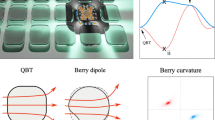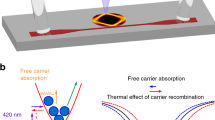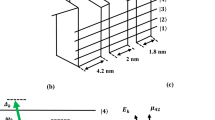Abstract
Non-Hermitian wave engineering has attracted a surge of interest in photonics in recent years. Prominent non-Hermitian phenomena include coherent perfect absorption and its generalization, reflectionless scattering modes, in which electromagnetic scattering at the input ports is suppressed due to critical coupling with the power leaked to output ports, and interference phenomena. These concepts are ideally suited to enable real-time dynamic control over absorption, scattering and radiation. Nonetheless, reflectionless scattering modes have not been observed in complex photonic platforms involving open systems and multiple inputs. Here we demonstrate the emergence of reflectionless scattering modes in a chaotic photonic microcavity involving over a thousand optical modes. We model the optical fields in a silicon stadium microcavity within a quasi-normal mode expansion, which is able to capture a dense family of reflection zeros at the input ports, associated with reflectionless scattering modes. We observe non-Hermitian degeneracies of reflectionless scattering modes in the telecommunication wavelength band, enabling efficient dynamic control over light radiation from the cavity.
This is a preview of subscription content, access via your institution
Access options
Access Nature and 54 other Nature Portfolio journals
Get Nature+, our best-value online-access subscription
$29.99 / 30 days
cancel any time
Subscribe to this journal
Receive 12 print issues and online access
$209.00 per year
only $17.42 per issue
Buy this article
- Purchase on Springer Link
- Instant access to full article PDF
Prices may be subject to local taxes which are calculated during checkout





Similar content being viewed by others
Data availability
Source data are provided with this paper. All other data that support the plots within this paper and other findings of this study are available from the corresponding author upon reasonable request.
Code availability
The codes and the in-house software used in this work are available upon request to the corresponding authors.
References
El-Ganainy, R. et al. Non-Hermitian physics and PT symmetry. Nat. Phys. 14, 11–19 (2018).
Bergholtz, E. J., Budich, J. C. & Kunst, F. K. Exceptional topology of non-Hermitian systems. Rev. Mod. Phys. 93, 015005 (2021).
Özdemir, K., Rotter, S., Nori, F. & Yang, L. Parity–time symmetry and exceptional points in photonics. Nat. Mater. 18, 783–798 (2019).
Bender, C. M. & Boettcher, S. Real spectra in non-Hermitian Hamiltonians having P T symmetry. Phys. Rev. Lett. 80, 5243 (1998).
Miri, M. A. & Alù, A. Exceptional points in optics and photonics. Science 363, eaar7709 (2019).
Wang, C. et al. Electromagnetically induced transparency at a chiral exceptional point. Nat. Phys. 16, 334–340 (2020).
Chong, Y. D., Ge, L., Cao, H. & Stone, A. D. Coherent perfect absorbers: time-reversed lasers. Phys. Rev. Lett. 105, 053901 (2010).
Wan, W. et al. Time-reversed lasing and interferometric control of absorption. Science 331, 889–892 (2011).
Pichler, K. et al. Random anti-lasing through coherent perfect absorption in a disordered medium. Nature 567, 351–355 (2019).
Imani, F. M., Smith, D. R. & del Hougne, P. Perfect absorption in a disordered medium with programmable meta-atom inclusions. Adv. Funct. Mater. 30, 2005310 (2020).
Sol, J., Alhulaymi, A., Stone, A. D. & del Hougne, P. Reflectionless programmable signal routers. Sci. Adv. 9, eadf0323 (2023).
Baranov, D. G., Krasnok, A., Shegai, T., Alù, A. & Chong, Y. Coherent perfect absorbers: linear control of light with light. Nat. Rev. Mater. 2, 17064 (2017).
Stone, A. D., Sweeney, W. R., Hsu, C. W., Wisal, K. & Wang, Z. Reflectionless excitation of arbitrary photonic structures: a general theory. Nanophotonics 10, 343–360 (2021).
Wang, C., Sweeney, W. R., Stone, A. D. & Yang, L. Coherent perfect absorption at an exceptional point. Science 373, 1261–1265 (2021).
Müllers, A. et al. Coherent perfect absorption of nonlinear matter waves. Sci. Adv. 4, eaat6539 (2018).
Roger, T. et al. Coherent perfect absorption in deeply subwavelength films in the single-photon regime. Nat. Commun. 6, 7031 (2015).
Sun, Y., Tan, W., Li, H. Q., Li, J. & Chen, H. Experimental demonstration of a coherent perfect absorber with pt phase transition. Phys. Rev. Lett. 112, 143903 (2014).
Slobodkin, Y. et al. Massively degenerate coherent perfect absorber for arbitrary wavefronts. Science 377, 995–998 (2022).
Soleymani, S. et al. Chiral and degenerate perfect absorption on exceptional surfaces. Nat. Commun. 13, 599 (2022).
Derode, A., Tourin, A. & Fink, M. Random multiple scattering of ultrasound. I. Coherent and ballistic waves. Phys. Rev. E 64, 036605 (2001).
Mosk, A. P., Lagendijk, A., Lerosey, G. & Fink, M. Controlling waves in space and time for imaging and focusing in complex media. Nat. Photon. 6, 283–292 (2012).
del Hougne, P., Lemoult, F., Fink, M. & Lerosey, G. Spatiotemporal wave front shaping in a microwave cavity. Phys. Rev. Lett. 117, 134302 (2016).
Rotter, S. & Gigan, S. Light fields in complex media: mesoscopic scattering meets wave control. Rev. Mod. Phys. 89, 015005 (2017).
Chen, L., Kottos, T. & Anlage, S. M. Perfect absorption in complex scattering systems with or without hidden symmetries. Nat. Commun. 11, 5826 (2020).
Li, H., Suwunnarat, S., Fleischmann, R., Schanz, H. & Kottos, T. Random matrix theory approach to chaotic coherent perfect absorbers. Phys. Rev. Lett. 118, 044101 (2017).
Choi, Y., Hahn, C., Yoon, J. W., Song, S. H. & Berini, P. Extremely broadband, on-chip optical nonreciprocity enabled by mimicking nonlinear anti-adiabatic quantum jumps near exceptional points. Nat. Commun. 8, 14154 (2017).
Wang, H., Assawaworrarit, S. & Fan, S. Dynamics for encircling an exceptional point in a nonlinear non-Hermitian system. Opt. Lett. 44, 638–641 (2019).
Alaee, R., Vaddi, Y. & Boyd, R. W. Dynamic coherent perfect absorption in nonlinear metasurfaces. Opt. Lett. 45, 6414–6417 (2020).
Soriano, M. C., García-Ojalvo, J., Mirasso, C. R. & Fischer, I. Complex photonics: dynamics and applications of delay-coupled semiconductors lasers. Rev. Mod. Phys. 85, 421–470 (2013).
Bender, N. et al. Depth-targeted energy delivery deep inside scattering media. Nat. Phys. 18, 309–315 (2022).
Redding, B. et al. Low spatial coherence electrically pumped semiconductor laser for speckle-free full-field imaging. Proc. Natl Acad. Sci. USA 112, 1304–1309 (2015).
VanWiggeren, G. D. & Roy, R. Communication with chaotic lasers. Science 279, 1198–1200 (1998).
Argyris, A. et al. Chaos-based communications at high bit rates using commercial fibre-optic links. Nature 438, 343–346 (2005).
Cao, H. & Wiersig, J. Dielectric microcavities: model systems for wave chaos and non-Hermitian physics. Rev. Mod. Phys. 87, 61–111 (2015).
Jiang, X. et al. Chaos-assisted broadband momentum transformation in optical microresonators. Science 358, 344–347 (2017).
Jiang, X., Qavi, A. J., Huang, S. H. & Yang, L. Whispering-gallery sensors. Matter 3, 371–392 (2020).
Kullig, J., Jiang, X., Yang, L. & Wiersig, J. Microstar cavities: an alternative concept for the confinement of light. Phys. Rev. Res. 2, 012072 (2020).
Shao, L. et al. Detection of single nanoparticles and lentiviruses using microcavity resonance broadening. Adv. Mater. 25, 5616–5620 (2013).
Jiang, X. F. et al. Highly unidirectional emission and ultralow-threshold lasing from on-chip ultrahigh-Q microcavities. Adv. Mater. 24, OP260–OP264 (2012).
Jiang, X.-F. et al. Free-space coupled, ultralow-threshold Raman lasing from a silica microcavity. Appl. Phys. Lett. 103, 101102 (2013).
Jiang, X.-F., Zou, C.-L., Wang, L., Gong, Q. & Xiao, Y.-F. Whispering-gallery microcavities with unidirectional laser emission. Laser Photon. Rev. 10, 40–61 (2016).
Yang, Q. F., Jiang, X. F., Cui, Y. L., Shao, L. & Xiao, Y. F. Dynamical tunneling-assisted coupling of high-Q deformed microcavities using a free-space beam. Phys. Rev. A 88, 023810 (2013).
Türeci, H. E., Schwefel, H. G. L., Jacquod, P. & Stone, A. D. in Progress in Optics Vol. 47 (ed. Wolf, E.) 75–137 (Elsevier, 2005).
Benzaouia, M., Joannopoulos, J. D., Johnson, S. G. & Karalis, A. Quasi-normal mode theory of the scattering matrix, enforcing fundamental constraints for truncated expansions. Phys. Rev. Res. 3, 033228 (2021).
Sweeney, W. R., Hsu, C. W. & Stone, A. D. Theory of reflectionless scattering modes. Phys. Rev. A 102, 063511 (2020).
Fyodorov, Y. V., Suwunnarat, S. & Kottos, T. Distribution of zeros of the S-matrix of chaotic cavities with localized losses and coherent perfect absorption: non-perturbative results. J. Phys. A 50, 30LT01 (2017).
Hentschel, M., Schomerus, H. & Schubert, R. Husimi functions at dielectric interfaces: inside-outside duality for optical systems and beyond. Europhys. Lett. 62, 636–642 (2003).
Bittner, S. et al. Suppressing spatiotemporal lasing instabilities with wave-chaotic microcavities. Science 361, 1225–1231 (2018).
Monifi, F. et al. Optomechanically induced stochastic resonance and chaos transfer between optical fields. Nat. Photon. 10, 399–405 (2016).
Zhang, J. et al. Optomechanical dissipative solitons. Nature 600, 75–80 (2021).
Horodynski, M., Kühmayer, M., Ferise, C., Rotter, S. & Davy, M. Anti-reflection structure for perfect transmission through complex media. Nature 607, 281–286 (2022).
Türeci, H. E., Ge, L., Rotter, S. & Stone, A. D. Strong interactions in multimode random lasers. Science 320, 643–646 (2008).
Redding, B., Choma, M. A. & Cao, H. Speckle-free laser imaging using random laser illumination. Nat. Photon. 6, 355–359 (2012).
Almeida, V. R., Panepucci, R. R. & Lipson, M. Nanotaper for compact mode conversion. Opt. Lett. 28, 1302–1304 (2003).
Balay, S. et al. PETSc Users Manual (Argonne National Laboratory, 2019).
Vicente, H., Roman, J. E. & Vidal, V. SLEPc: a scalable and flexible toolkit for the solution of eigenvalue problems. ACM Trans. Math. Softw. 31, 351–362 (2005).
Kucukcoban, S. & Kallivokas, L. F. A symmetric hybrid formulation for transient wave simulations in PML-truncated heterogeneous media. Wave Motion 50, 57–79 (2013).
Acknowledgements
We thank Z. Li at Stevens Institute of Technology for polishing the edge couplers. This work was supported by the Air Force Office of Scientific Research and the Simons Foundation. Fabrication of samples for this work was performed at the Nanofabrication Facility at the Advanced Science Research Center at The Graduate Center of the City University of New York.
Author information
Authors and Affiliations
Contributions
X.J., S.Y. and A.A. conceived the project. X.J. fabricated the device and designed the experiments. X.J. and S.Y. performed the experiments and analysed experimental data with help from J.Q., M.C. and A.A. Theoretical studies and full-wave simulations were performed by S.Y. with help from X.J., H.L., J.K., J.W. and A.A. Study of reflection zeros were performed by H.G. and S.Y. All authors discussed the results. A.A. supervised the project. X.J., S.Y. and A.A. wrote the paper with input from all co-authors.
Corresponding author
Ethics declarations
Competing interests
The authors declare no competing interests.
Peer review
Peer review information
Nature Physics thanks A. Stone and the other, anonymous, reviewer(s) for their contribution to the peer review of this work.
Additional information
Publisher’s note Springer Nature remains neutral with regard to jurisdictional claims in published maps and institutional affiliations.
Supplementary information
Supplementary Information
Supplementary Figs. 1–9 and Discussion Sections I–VIII.
Source data
Source Data Fig. 1
b, Eigenfrequencies across Re(kR) = 25.0–29.2. c, Mode contributions from 47 notable quasi-normal modes. d, Magnitudes of the eigenvalues of the truncated scattering matrix. e, Complex reflection zeros across Re(kR) = 25.0–29.2.
Source Data Fig. 3
a, Reflectance across 1,520–1,545 nm for different relative phases. b–c, Reflectance at RSM(±) for different relative phases. d,g, Two-dimensional data of Husimi plots.
Source Data Fig. 4
Radiated power at different relative phases.
Source Data Fig. 5
a, Reflectance at RSM degeneracy for different relative phases. b, Radiated power at different relative phases at RSM degeneracy. d, Radiated power at different relative phases at different angles at RSM degeneracy.
Rights and permissions
Springer Nature or its licensor (e.g. a society or other partner) holds exclusive rights to this article under a publishing agreement with the author(s) or other rightsholder(s); author self-archiving of the accepted manuscript version of this article is solely governed by the terms of such publishing agreement and applicable law.
About this article
Cite this article
Jiang, X., Yin, S., Li, H. et al. Coherent control of chaotic optical microcavity with reflectionless scattering modes. Nat. Phys. 20, 109–115 (2024). https://doi.org/10.1038/s41567-023-02242-w
Received:
Accepted:
Published:
Issue Date:
DOI: https://doi.org/10.1038/s41567-023-02242-w
This article is cited by
-
Anti-laser shows how to make waves behave
Nature Physics (2024)



